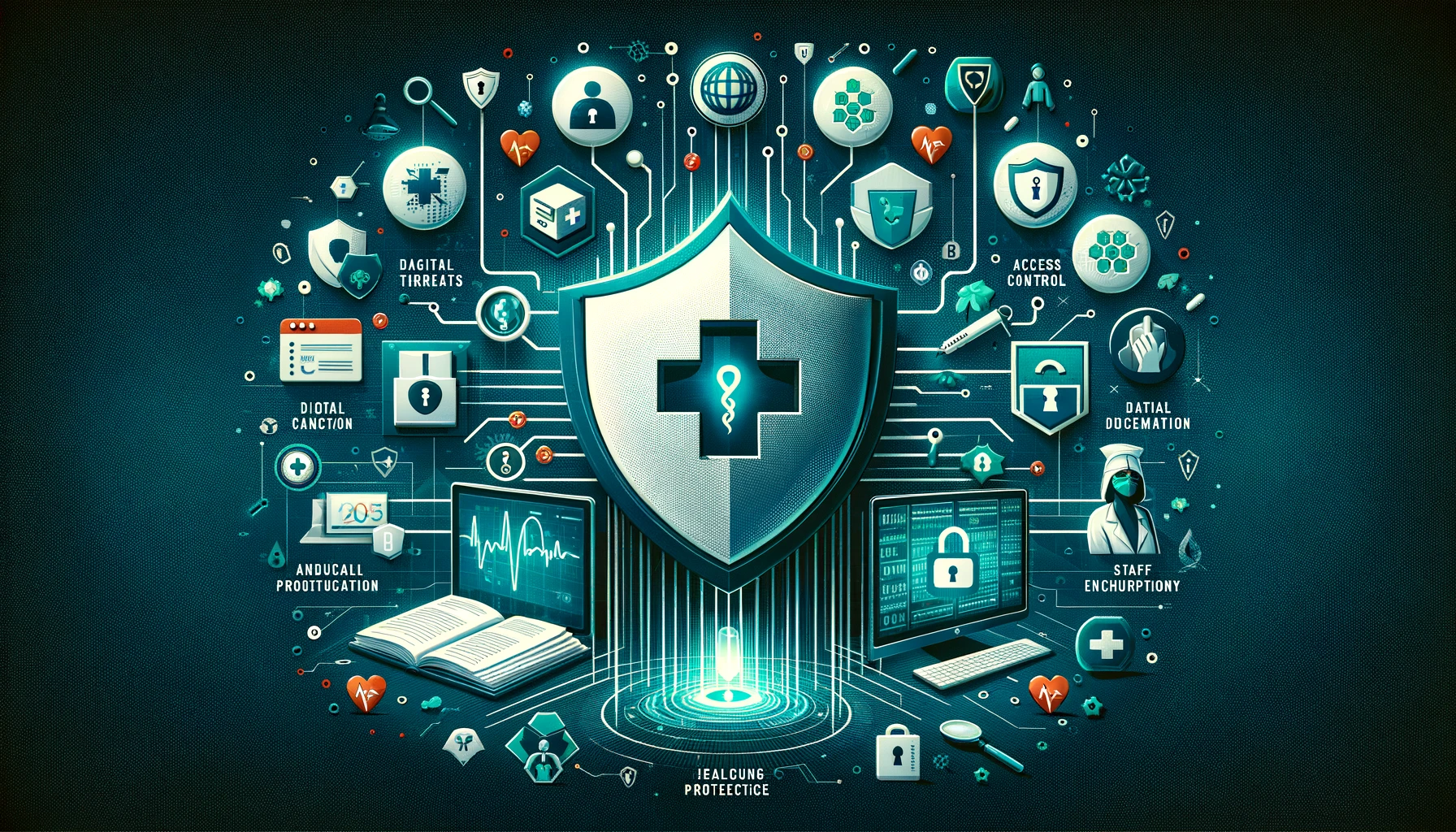
5 Key Strategies for Safe Patient Data Security
In today's digital age, keeping patient records safe is absolutely essential for those in the healthcare game. With cyber attacks coming left, right and centre, you've got to have solid plans in place to protect that precious data. So let's dive into five top-notch tactics that'll help secure your healthcare info against unwanted intrusions. We're all about upping the secrecy and trustworthiness of patient details here – we want it locked down tight so no sneaky peeks happen without permission.
Identifying the Top Threats in Healthcare Data Security

The healthcare industry is rapidly moving into the digital age, amassing huge piles of confidential patient details that become a goldmine for dodgy characters with bad intentions. Curious about the top threats waiting to pounce? Headline-stealing cyber-attacks are right up there, especially ransomware that locks away important files and throws hospitals into chaos until they cough up cash. But hey, don't forget—sometimes trouble comes from inside our own camp! You might find staff bungling sensitive information out of spite or just by not knowing any better.
Then there's phishing—a real sticky wicket where one wrong click on a fishy link could land the whole team in hot water. Ever thought about those simpler slip-ups like losing hardware? Picture this: someone nicks off with devices stuffed full of personal health records—that's no walk in the park either! To cap it all off, imagine your private medical history taking an unauthorized tour through shady corners of Dark Web markets—it doesn’t bear thinking about!
It's not all bad news, though. By putting these threats under the microscope, healthcare organisations can prep their defences better. Spotting them is just step one – how do we jump into action off the back of this alertness? You've heard it before: know your adversary and you're halfway to victory, right?Getting clued up on these dangers shapes our defence strategy. Take phishing; if we suss out its frequency, we'll chuck resources into savvy tools and training that spot those tricks a mile away. And understanding physical theft hazards means cracking down with top-notch security for gadget storage and sensitive data carriers.So what happens post-identification? How about rolling up our sleeves to construct some solid walls against these looming menaces?
Implementing Robust Access Controls to Safeguard Patient Information

Bearing the lurking dangers in mind, let's navigate through the bastion that is access controls. Think of it as choosing who gets keys to your realm; you're dead set on allowing only the chosen few to pass through those gates. 'Least Privilege' ought to be etched into every aspect of our access control tactics, limiting folks strictly to what they need for their roles – no more and certainly no less.
Your patient information isn't up for grabs by just anyone—it shouldn't turn into a free-for-all! Imagine if all members of staff could waltz right in and peek at whatever data caught their fancy—that'd be an absolute nightmare for security! By setting up role-based permissions, healthcare institutions can dramatically slash chances of sneaky peeks from unauthorised eyes. Yet have you spared a thought about locums or visiting contractors? Ensuring there’s a swift way to cut off their entry once they've finished is crucial—surely that's just plain logic?
In today's digital world, think of biometric authentication and multi-factor authentication as your trusty gatekeepers. They've kicked the old-school password systems to the curb, making sure that whoever knocks on your door is exactly who they say they are. Doesn't it just ease your mind to know a lost password can’t unleash chaos with your data?
However, setting up access controls isn't a one-off job – it’s an ever-evolving task! These safeguards need regular tweaks and tune-ups to mirror any shift in staff positions or duties. It keeps you on your toes, doesn't it? Employees come and go - surely you wouldn’t fancy having former team members still roaming around in cyberspace with their old keys! So how do we keep track that everyone's entry rights stay fresh and fitting?
Regular Audits and Monitoring to Prevent Healthcare Breaches
Audit trails and vigilant monitoring stand guard over the security of healthcare data. Think of regular audits as your data security's routine GP visits – they're there to spot any weaknesses before they worsen into severe issues. By keeping detailed records of every peek and tweak made to patient information, organisations have the power to track down oddities or unapproved activities straight back to their roots. But just how frequently should these checks be done for them to really make a difference?Then you've got continuous monitoring - it's like having CCTV on 24/7, tirelessly watching out for anything dodgy going on with your data. It’s simply not enough leaning on yearly audits; breaches can strike faster than batting an eyelid! Security squads must stay sharp round-the-clock in this relentless chase between hackers and defenders – do you get how much commitment that takes? Keeping an ever-watchful eye across an ocean of bytes is no small feat, I tell ya!
Audits are real eye-openers, don't you think? They shine a spotlight on places where your team might need a bit more know-how or where the cogs in your process could do with some tightening. But let's chew over this – is that all they're good for? It seems audits also act like a gentle nudge of caution, reminding everyone that being answerable is just part and parcel of juggling healthcare data. And hold on, we mustn't overlook the watchful eyes of regulators. Should any slip-ups occur, having those meticulous audit trails can be your knight in shining armour; they prove you've done what’s expected and might even lighten any penalties thrown your way.
Now here comes the tricky question: how do we strike that perfect balance between stringent auditing and keeping our healthcare services smooth-sailing? Honestly, it feels like trying to walk across a tightrope stretched between fortress-like security measures and slick operational efficiency - quite the balancing act!
Training Staff on Best Practices for Protecting Patient Data

Oftentimes, it's us humans that end up being the weak spot in our security measures. Now, nobody's saying loyal employees are out there to compromise sensitive patient information on purpose; a lot of times they're just unaware of what their actions might lead to. So how do we tackle this? Well-crafted training sessions tailored for healthcare professionals can turn things around – from accidental risks into staunch guardians of confidential data.
But hold on a minute, what exactly needs to be wrapped up in these trainings so they really hit the mark? Bringing real-world situations and interactive elements into play certainly helps knowledge stick better than glue! Just reading about phishing attacks is one thing but actually going through them hands-on (in a totally risk-free setting)? That changes everything. And if you toss in personalised examples showing just how much damage could come knocking at someone’s door due to careless handling of data... well then, you've got yourself some seriously powerful teaching moments right there.
Cultivating a mindset where security falls on all of our shoulders is key. We need to make everyone in the workplace comfortable enough to flag up any dodgy-looking chinks without worrying about getting into trouble. But what's the trick to promoting this transparency and avoiding a storm of worry or finger-pointing? Bear in mind that as tech marches forward, those pesky threats are hot on its heels. Continual learning is vital—it's not just about ticking off that initial training session box. So how can we keep our cyber savvy updated with these relentless changes, eh?
Embracing Encryption and Other Tech Solutions for Enhanced Security

Think of encryption as a mysterious superhero, valiantly defending the privacy of patient records by turning them into scrambled code—a puzzle too tough for even top-notch hackers to solve. Yet, its strength lies in how well it's put into play. Are our healthcare providers on their toes, making sure every shred of data is shielded with top-level encryption both when stored and whilst zipping through cyberspace?
Let’s chat about firewalls and anti-malware tools—the cyber world's answer to moats and fortified gates guarding confidential health information castles. But here comes the crucial bit: are they consistently refreshed to keep up with newfangled hacking tricks? Cyber threats morph at lightning speed; hence defence systems need rapid reflexes—staying nimble yet solid as rock.
Cybersecurity isn't static—it demands vigilance! So we've got to ask ourselves if those running the show in healthcare institutions have what it takes—is their security game sharp enough? Can they ensure these digital shields remain stout against ever-evolving hazards?
Think about it: we're living in a world chock-full of big data and AI wizardry, where advanced analytics are key to spotting and nipping risks in the bud. Ever fancied predicting a security breach before it even cracks open, using nothing but trends and patterns from your data? Sounds pretty sci-fi, doesn't it? And let's not sidestep blockchain – that gem with its ironclad promise for keeping records safe as houses. When you think about safeguarding healthcare details, the impact could be huge! The real question is though – can our tech-savvy providers truly get behind this revolution without stumbling over the hurdles?
Conclusion
In the fast-paced world of healthcare, it's critical to keep patient data under lock and key. We've got to stick closely to top-notch security practices while keeping our eyes peeled for any potential threats that could compromise sensitive info.It takes a cocktail of savvy tech solutions and strict policy application – think cutting-edge tools mixed with ironclad rules – so we can dodge those risks head-on. Trust in our health systems? It stays rock-solid because of this dedication.Every one of us has a part to play, throwing their weight behind these essential safeguards. After all, protecting privacy and upholding high standards is what exceptional patient care is built on.Fancy moving things along your path? Don't let an ace chance slip through your fingers! Our experts are primed just for you—so why not book yourself into a free chat? Click down there when you're ready; find the perfect slot; then hey presto—it’s lift-off time on reaching those ambitions!
Find Out How We Can Protect Your Medical Practice



